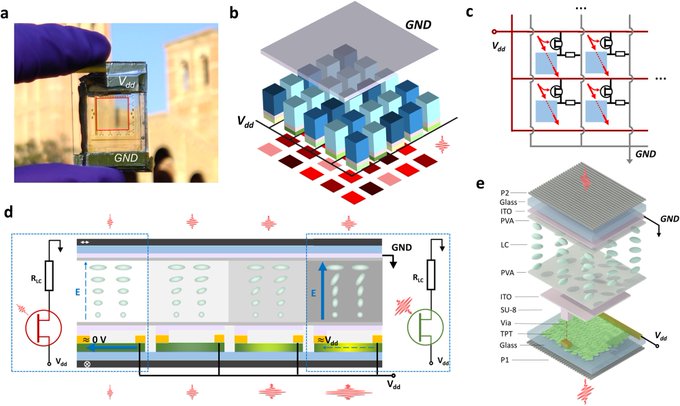Summary:
UCLA researchers in the Departments of Chemistry & Biochemistry and Materials Science & Engineering have developed a novel optoelectronic neuron array for computational imaging and sensing applications that can work under weak broadband incoherent light.
Background:
Nonlinear optical processing of ambient light is desirable for its ability to enhance information in light, reduce noise, and benefit both computational imaging and sensing. For applications such as security, autonomous vehicles, photography, and machine vision, energy loss must be minimal to preserve as much information as possible and the nonlinear layer must operate well at low intensities and high frame rates. To achieve strong nonlinear responses, the material must undergo chemical or physical changes induced by light. In standard devices, this requires either quickly absorbing a large number of photons which requires intense illumination or capturing a smaller amount of photons and gradually accumulating changes over time, giving more transparency but a slower response. Current challenges to the use of nonlinear arrays are limitations on available materials, demands for broadband response, and a large required nonlinear coefficient. There is an obvious need for a nonlinear optical processing array that can exceed these challenging demands and avoid the tradeoff among power, speed, and transparency.
Innovation:
Researchers led by Professors Duan and Ozcan developed a novel optoelectronic array that enabled an intelligent imaging system to instantly reduce input glares while retaining the weaker-intensity objects within the field of view. This technology operates over a broad spectrum of light at an intensity orders of magnitude lower than previous materials. The array can rapidly respond to dynamically varying illumination conditions and greatly increases the signal to noise ratio under varying lighting conditions. Advantages such as these are highly desirable for a wide array of applications including security, autonomous vehicle navigation and computer vision. In a 10,000-pixel array used in conjunction with a cellphone-based imaging system, intelligent glare reduction was achieved by specifically diminishing bright glares while conserving adjacent details which would be otherwise unrecognizable by the camera. This array reacted much faster to changes in lighting conditions compared to existing software-controlled auto-exposure systems. Fast response times of around 17 milliseconds were possible with this novel system, which is faster than the frame rate of the camera and surpasses the software auto-exposure control at 0.8 seconds by far.

Credit: biophotonics@UCLA/X
Demonstration Video:
Optoelectronic Neuron Array for Nonlinear Optical Modulation and AI Cameras
Press Release:
UCLA Newsroom: Advance in light-based computing shows capabilities for future smart cameras
Potential Applications:
- Optical computing
- Autonomous driving
- Machine vision
- Security cameras
- Image sensor with fast auto-exposure for photography
- Defense applications (aviation; maritime; aerospace)
- Robotics
Advantages:
- Fast processing time
- Instant exposure response in varying lighting conditions
- Glare reduction
- Broadband capabilities
- Low light functionalities
Development-To-Date:
A 10,000-pixel array has been fabricated and described in a publication
Publications:
Zhang, D., Xu, D., Li, Y. et al. Broadband nonlinear modulation of incoherent light using a transparent optoelectronic neuron array. Nat Commun 15, 2433 (2024). https://www.nature.com/articles/s41467-024-46387-5
Reference:
UCLA Case No. 2023-208
Lead Inventors: Aydogan Ozcan, Xiangfeng Duan